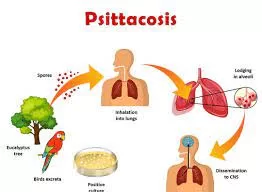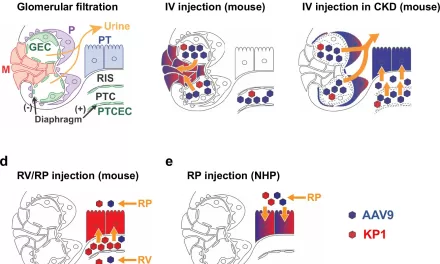Situation at a Glance
Description of the Situation
Austria
In Austria, 14 confirmed cases of psittacosis were reported from five of the nine federal states in 2023, compared to the median of two cases (range: 1-4) per year in the previous eight years. In 2024, there have been four cases of psittacosis reported as of 4 March 2024, with the earliest onset date of 24 January 2024. None of these unrelated cases notified in 2023 or 2024 have reported travel abroad and wild birds have not been mentioned as a source of infection.
In Austria, suspected and confirmed psittacosis cases, as well as deaths due to psittacosis are notifiable. The country did not report changes in diagnostic procedures (currently reverse transcription polymerase chain reaction (RT-PCR) is used) that could explain this increase in reported psittacosis cases.
Denmark
Denmark reported a marked increase in psittacosis cases from late 2023 to mid-January 2024. As of 27 February 2024, 23 individuals tested positive for C. psittaci via RT-PCR. Most of the cases were reported from the North Denmark Region, Zealand Region, and the Capital Region. Seventeen cases (74%) were hospitalized, of whom 15 had pneumonia and four died.
From the epidemiological investigations, one case has been linked to domestic birds that tested positive for C. psittaci. Of the 15 other cases with exposure information available, 12 (80%) have indicated contact with wild birds (primarily via bird feeders). For three cases there is no information available on bird exposures, and for the remaining four cases, no direct bird contact has been reported. Transmission from chickens has been ruled out by testing of suspected birds in two of the cases with reported bird contact.
Over the past five years, Denmark has reported between 15 to 30 human cases annually, most of which have been linked to exposure to domestic birds (e.g. parrots, parakeets, hobby birds such as racing pigeons) and ducks handled during hunting; however, each year several cases report no direct contact with birds, which suggests potential environmental exposure. There is no indication of increased testing or change in testing procedures in Denmark that could explain the current increase in psittacosis cases.
The National Health Institute of Denmark, Statens Serum Institute, suspects that infections are primarily associated with wild birds through the inhalation of airborne particles from the dried droppings of infected birds. The prevalence of C. psittaci among wild birds in Denmark is currently unknown, and plans are underway to examine samples from wild birds submitted for avian influenza testing to clarify this. It is assumed that the actual number of individuals infected with C. psittaci is much higher than reported. Some cases may be associated with exposure to domesticated psittacines (including parrots) or other birds that can carry the bacteria asymptomatically.
Germany
Germany reported an increase in individuals who tested positive for C. psittaci in December 2023 with five confirmed cases, making a total of 14 confirmed cases in 2023. In 2024, as of 20 February, another five confirmed cases of psittacosis were notified. There are no reports of a geographical cluster, except with an accumulation of cases around the city of Hannover over the last year. Almost all cases had pneumonia (18/19), 16 of whom were hospitalized.
Among the 19 cases notified from 1 January 2023 to 19 February 2024, none had information on exposure to wild birds, although 26% (5/19) of cases reported exposure to domesticated birds such as parrots, chickens, or breeding pigeons.
Over the past five years, Germany has reported an average of 15 cases per year, with the highest number of cases in 2022 (19 cases) and the lowest number in 2019 (11 cases). Usually, around zero to two cases per month are reported. Around 72% (56/78) of the cases in the last five years were confirmed by antibody testing. Information on bird exposure is often missing.
Sweden
Sweden reported an unusually high number of cases of psittacosis in late November 2023 and early December 2023, with seven cases reported in November 2023 and 19 cases reported in December 2023. This represents a doubling of the number of cases compared to respective months in the previous five years.
In 2024, however, ten cases were reported in January and three cases in February, which is lower than the average number of cases reported in the same period in the previous five years. Overall, Sweden reported an increase in the number of reported cases of psittacosis from 2017 onwards.
Geographically, cases reported as of early November 2023, are distributed between eight of the 21 regions of Sweden, all located in the southernmost third of the country. Reported cases have been in contact with droppings from small birds, mainly via feeders, and a few are thought to have been infected via domestic birds (hens or cockatoos).
Changes in diagnostic practices have likely contributed to this increase, as it has become increasingly common to use RT-PCR panels for screening.
The Netherlands
The Netherlands observed an increase of confirmed psittacosis cases since late December 2023, with 21 individuals reported as positive for C. psittaci as of 29 February 2024, which is twice as many cases as the same period in previous years. Over the past ten years, there has been an average of nine cases reported during the same period.
Recent cases have been geographically spread throughout the country with no common source of infection being identified. The cases had an average age of 67 (range: 37-86 years), of whom 16 were men (76%). All recent cases were hospitalized and one case died. Six of the 21 cases reported since late December 2023 have noted contact with droppings of wild birds, seven had contact with droppings of domestic birds, and eight cases did not report any contact with birds.
Testing procedures have not changed in recent years in the Netherlands. Since 2018, more than 95% of the notifications are based on RT-PCR testing.
Epidemiology
Chlamydophila psittaci is a bacterium that causes the zoonotic disease of psittacosis in humans. Human infections are generally associated with those who work with pet birds, poultry workers, veterinarians, pet bird owners, and gardeners in areas where C. psittaci is epizootic in the native bird population.
C. psittaci is associated with more than 450 avian species and has also been found in various mammalian species, including dogs, cats, horses, large and small ruminants, swine, and reptiles. However, birds, especially pet birds (psittacine birds, finches, canaries, and pigeons), are most frequently involved in causing human psittacosis. Disease transmission to humans occurs mainly through inhalation of airborne particles from respiratory secretions, dried faeces, or feather dust. Direct contact with birds is not required for infection to occur.
In general, psittacosis is a mild illness, with symptoms including fever and chills, headache, muscle aches and dry cough. Most people begin developing signs and symptoms within 5 to 14 days after exposure to the bacteria. Prompt antibiotic treatment is effective and allows avoiding complications such as pneumonia. With appropriate antibiotic treatment, psittacosis rarely (less than 1 in 100 cases) results in death.
Public Health Response
Human psittacosis is a notifiable disease in the concerned countries. Epidemiological investigations were implemented to identify potential exposure and clusters of cases.
National surveillance systems are closely monitoring the situation, including laboratory analysis of samples from wild birds submitted for avian influenza testing to verify the prevalence of C. psittaci among wild birds.
WHO Risk Assessment
Overall, five countries in the WHO European region reported an unusual and unexpected increase in reports of cases of C. psittaci. Some of the reported cases developed pneumonia and resulted in hospitalization, and fatal cases were also reported.
Sweden has reported a general increase in psittacosis cases since 2017, which could be associated with the increased use of more sensitive polymerase chain reaction (PCR) panels. The increase in reported psittacosis cases across all countries requires additional investigation to determine whether it is a true increase in cases or an increase due to more sensitive surveillance or diagnostic techniques.
While birds that carry this disease could be crossing international borders, there is currently no indication of this disease being spread by humans nationally or internationally. Generally, people do not spread the bacteria that causes psittacosis to other people, so there is a low likelihood of further human-to-human transmission of the disease. If correctly diagnosed, this pathogen is treatable by antibiotics.
WHO continues to monitor the situation, and based on the available information, assesses the risk posed by this event as low.
WHO Advice
WHO recommends the following measures for the prevention and control of psittacosis:
- increasing the awareness of clinicians to test suspected cases of C. psittaci for diagnosis using RT-PCR.
- increasing awareness among caged or domestic bird owners, especially psittacines, that the pathogen can be carried without apparent illness.
- quarantining newly acquired birds. If any bird is sick, contact the veterinarian for an examination and treatment.
- conducting surveillance of C. psittaci in wild birds, potentially including existing specimens collected for other reasons.
- encouraging people with pet birds to keep cages clean, position cages so that droppings cannot spread among them and avoid over-crowded cages.
- promoting good hygiene, including frequent hand washing, when handling birds, their faeces, and their environments.
- standard infection-control practices and droplet transmission precautions should be implemented for hospitalized patients.
Further Information
- United States Centers for Disease Control and Prevention. Psittacosis.
- World Organization for Animal Health. Avian chlamydiosis.
- World Health Organization. International Health Regulations
- Inchuai R, Weerakun S, Nguyen HN, Sukon P. Global Prevalence of Chlamydial Infections in Reptiles: A Systematic Review and Meta-Analysis. Vector Borne Zoonotic Dis. 2021;21(1):32-39. https://doi.org/10.1089/vbz.2020.2654
- Stokes HS, Berg ML, Bennett ATD. A Review of Chlamydial Infections in Wild Birds. Pathogens. 2021;10(8):948. Published 2021 Jul 28. doi:10.3390/pathogens10080948
- Dembek ZF, Mothershead JL, Owens AN, Chekol T, Wu A. Psittacosis: An Underappreciated and Often Undiagnosed Disease. Pathogens. 2023;12(9):1165. Published 2023 Sep 15. doi:10.3390/pathogens12091165
Citable reference: World Health Organization (5 March 2024). Disease Outbreak News; Psittacosis – European region. Available at: https://www.who.int/emergencies/disease-outbreak-news/item/2024-DON509











